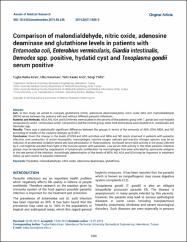| dc.contributor.author | Kıran, Tuğba Raika | |
| dc.contributor.author | Karaman, Ülkü | |
| dc.contributor.author | Arıcı, Yeliz Kaşko | |
| dc.contributor.author | Yıldız, Sevgi | |
| dc.date.accessioned | 2021-07-12T07:10:00Z | |
| dc.date.available | 2021-07-12T07:10:00Z | |
| dc.date.issued | 2019 | en_US |
| dc.identifier.citation | Kiran, T. R, Karaman, Ü, Arici, Y. K, Yildiz, S. (2019). Comparison of malondialdehyde, nitric oxide, adenosine deaminase and glutathione levels in patients with Entamoeba coli, Enterobius vermicularis, Giardia intestinalis, Demodex spp. positive, hydatid cyst and Toxoplasma gondii serum positive. Annals of Medical Research, 26(7), 1420 - 1425. https://doi.org/10.5455/annalsmedres.2019.05.236 | en_US |
| dc.identifier.uri | https://doi.org/10.5455/annalsmedres.2019.05.236 | |
| dc.identifier.uri | https://hdl.handle.net/20.500.12508/1871 | |
| dc.description.abstract | Aim: In this study we aimed to compare glutathione (GSH), adenosine deaminase(ADA), nitric oxide (NO) and malondialdehyde (MDA) values between the patients with and without different parasitic infections. Material and Methods: MDA, NO, ADA and GSH levels were studied in the serums of the patients group with T. gondii and cyst hydatid seropositivity and E. vermicularis and E. coli positive and the control group, while ADA levels alone were studied in G. intestinalis and Demodex spp. Results: There was a statistically significant difference between the groups in terms of the amounts of ADA, GSH, MDA, and NO according to results of the variance analysis (p<0.001). Conclusion: Given the change in the levels of GSH and ADA activities and MDA and NO levels observed in patients with parasitic infection, over production of active neutrophils, macrophages, reactive oxygen radicals and reactive nitrogen species may be an indicator of accelerated oxidative stress and lipid peroxidation in these patients. Increased serum ADA activity in the group infected by E. coli might be resulted from fight of the immune system with parasites. Low serum ADA activity in the other parasitic infection groups may be explained by suppression of lymphocyte proliferation by macrophages that were activated by sporozoite antigens in the late period of the infection. Accordingly, determination of the levels of MDA, NO, ADA and GSH may be important in treatment follow up and control of parasitic infections. | en_US |
| dc.language.iso | eng | en_US |
| dc.publisher | Annals of Medical Research | en_US |
| dc.relation.isversionof | 10.5455/annalsmedres.2019.05.236 | en_US |
| dc.rights | info:eu-repo/semantics/openAccess | en_US |
| dc.subject | Parasites | en_US |
| dc.subject | Malondialdehyde | en_US |
| dc.subject | Nitric oxide | en_US |
| dc.subject | Adenosine deaminase | en_US |
| dc.subject | Glutathione | en_US |
| dc.title | Comparison of malondialdehyde, nitric oxide, adenosine deaminase and glutathione levels in patients with Entamoeba coli, Enterobius vermicularis, Giardia intestinalis, Demodex spp. positive, hydatid cyst and Toxoplasma gondii serum positive | en_US |
| dc.type | article | en_US |
| dc.relation.journal | Annals of Medical Research | en_US |
| dc.contributor.department | Mühendislik ve Doğa Bilimleri Fakültesi -- Biyomedikal Mühendisliği Bölümü | en_US |
| dc.identifier.volume | 26 | en_US |
| dc.identifier.issue | 7 | en_US |
| dc.identifier.startpage | 1420 | en_US |
| dc.identifier.endpage | 1425 | en_US |
| dc.relation.publicationcategory | Makale - Ulusal Hakemli Dergi - Kurum Öğretim Elemanı | en_US |
| dc.contributor.isteauthor | Kıran, Tuğba Raika | |
| dc.relation.index | TR-Dizin | en_US |
















